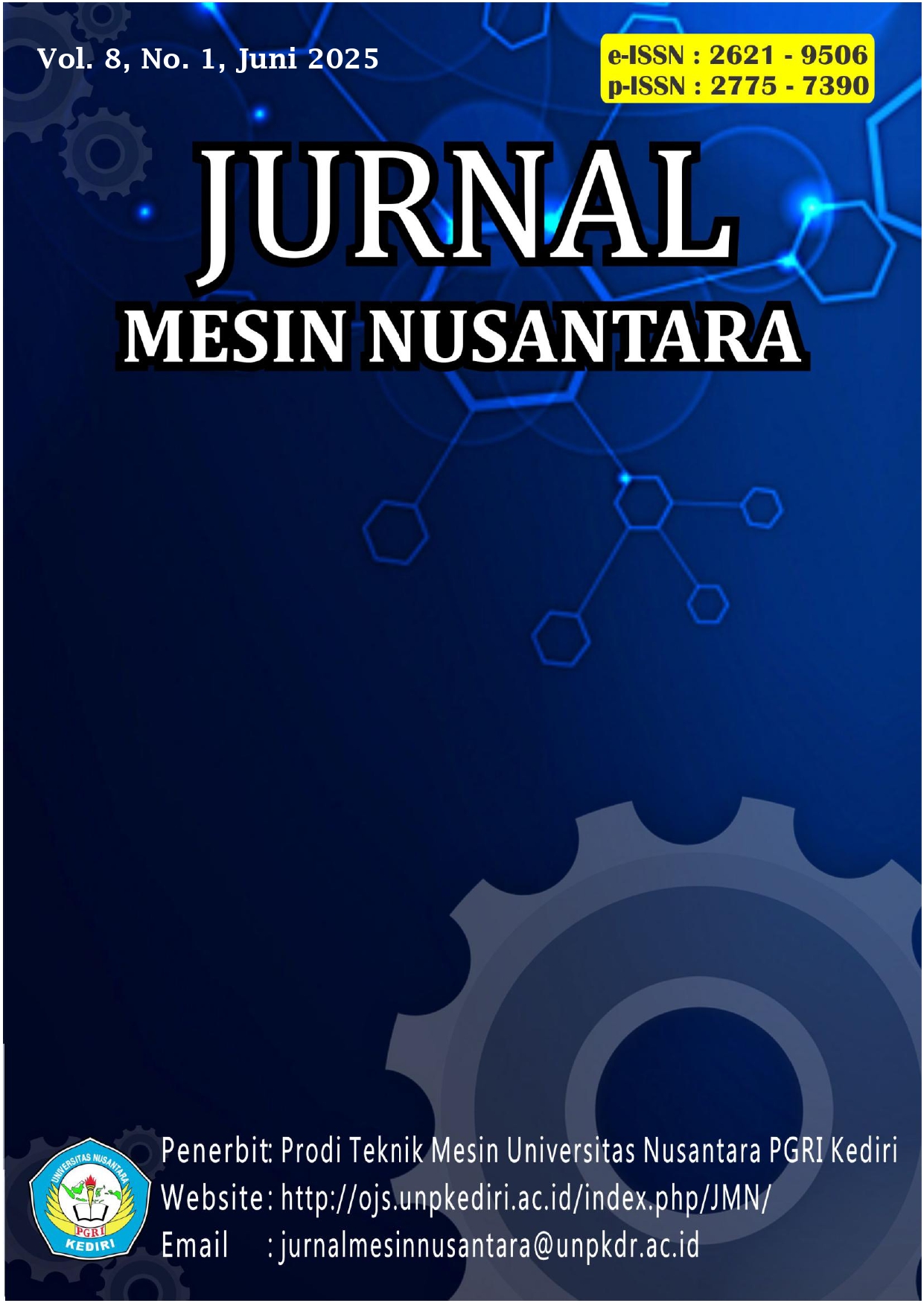Pengaruh Aspek Rasio Pad Terhadap Efektivitas Pendingin Evaporatif Berbahan Serabut Kelapa
DOI:
https://doi.org/10.29407/jmn.v8i1.24741Keywords:
Aspek Rasio Pad, Cooling Pad, Pendingin Evaporatif, Putaran BlowerAbstract
Krisis energi dan perubahan iklim meningkatkan konsumsi energi untuk pemanasan dan pendinginan ruang, dengan sektor ini menyumbang 33% dari konsumsi energi global. Pendinginan udara mencapai 60% dari permintaan listrik musim panas, sehingga konservasi energi penting. Sistem pendinginan evaporatif, dengan cooling pad berbasis serabut kelapa, menjadi solusi yang efektif. Adapun tujuan dari penelitian ini yaitu untuk mengetahui pengaruh aspek rasio pad terhadap efektivitas pendingin evaporatif berbahan serat kelapa. Penelitian ini dilakukan secara eksperimen pada ruang dengan dimensi 244 cm x 122 cm x 122 cm dengan merubah variasi aspek ratio pad 60:3, 60:6, 60:9 dan putaran blower 830 rpm, 1030 rpm, 1230 rpm. Berdasarkan hasil penelitian efektivitas pendinginan evaporatif meningkat dengan menurunnya aspek rasio pad. Efektivitas meningkat karena serabut kelapa dapat menyerap lebih banyak air, meningkatkan penguapan dan penyerapan panas. Ketebalan pad yang lebih besar menambah hambatan aliran udara, tetapi meningkatkan interaksi udara dan air, sehingga lebih banyak panas diserap. Namun, pada aspek rasio 60:9 dengan putaran blower 1030 rpm, terjadi penurunan efektivitas karena suhu udara yang dikeluarkan tidak mendekati suhu bola basah, menunjukkan penguapan air tidak maksimal. Peningkatan putaran blower meningkatkan transfer massa antara udara dan air, menghisap lebih banyak udara panas, dan meningkatkan laju penguapan air, meskipun interaksi udara dan air menjadi lebih singkat. Blower juga membantu mengurangi panas di ruangan dengan membuang udara panas ke luar dan menggantinya dengan udara lebih dingin.
Downloads
References
[1] O. Amer, R. Boukhanouf, and H. Ibrahim, “A Review of Evaporative Cooling Technologies,” in 2014 APCBEES Nottingham Conferences Proceeding, 2014, pp. 119–125.
[2] S.-H. Sellam et al., “Experimental performance evaluation of date palm fibers for a direct evaporative cooler operating in hot and arid climate,” Case Studies in Thermal Engineering, vol. 35, pp. 1–18, Jul. 2022, doi: 10.1016/j.csite.2022.102119.
[3] N. Kapilan, A. M. Isloor, and S. Karinka, “A comprehensive review on evaporative cooling systems,” Jun. 01, 2023, Elsevier B.V. doi: 10.1016/j.rineng.2023.101059.
[4] A. Tejero-González and A. Franco-Salas, “Optimal operation of evaporative cooling pads: A review,” Nov. 01, 2021, Elsevier Ltd. doi: 10.1016/j.rser.2021.111632.
[5] M. K. Chopra and R. Kumar, “Design of New Evaporative Cooler and Usage of Different Cooling Pad Materials for Improved Cooling Efficiency,” International Research Journal of Engineering and Technology, vol. 04, no. 09, pp. 503–511, 2017, [Online]. Available: www.irjet.net
[6] Mhd. I. Nusa, “Evaporative Cooling Technology To Prolong Shelf Life Storage Of Fresh Fruits And Vegetable,” vol. 19, no. 3, pp. 281–288, 2015.
[7] I. putu M. Adnyana, N. L. P. I. Midiani, and I. M. R. J. Widanta, “Pengaruh Perlakuan Cooling Pad Terhadap Performanci Evaporative Cooling,” pp. 1–8, 2022, [Online]. Available: https://repository.pnb.ac.id
[8] R. P. Rachman and B. Yunianto, “Pengaruh Jenis Sprayer Terhadap Efektivitas Direct Evaporative Cooling Dengan Cooling Pad Serabut Kelapa,” 2014.
[9] R. Rawangkul, J. Khedari, J. Hirunlabh, and B. Zeghmati, “Performance analysis of a new sustainable evaporative cooling pad made from coconut coir,” International Journal of Sustainable Engineering, vol. 1, no. 2, pp. 117–131, Jun. 2008, doi: 10.1080/19397030802326726.
[10] R. A. Aziz, N. Farahin Zamrud, and N. Rosli, “Comparison on cooling efficiency of cooling pad materials for evaporative cooling system,” 2018. [Online]. Available: http://journal.ump.edu.my/jmmst
[11] M. D. Ardhiansyah and Sardiwi, “Pengaruh Pemanfaatan Sabut Kelapa Sebagai Material Serat Terhadap Kuat Tekan Dan Daya Serap Beton”.
[12] M. F. Alam, A. S. Sazidy, A. Kabir, G. Mridha, N. A. Litu, and M. A. Rahman, “An experimental study on the design, performance and suitability of evaporative cooling system using different indigenous materials,” in AIP Conference Proceedings, American Institute of Physics Inc., Jun. 2017. doi: 10.1063/1.4984704.
[13] A. Malli, H. R. Seyf, M. Layeghi, S. Sharifian, and H. Behravesh, “Investigating the performance of cellulosic evaporative cooling pads,” Energy Convers Manag, vol. 52, no. 7, pp. 2598–2603, 2011, doi: 10.1016/j.enconman.2010.12.015.
[14] I. N. Suryana, I. N. Suarnadwipa, and H. Wijaksana, “Studi Eksperimental Performansi Pendingin Evaporative Portable Dengan Pad Berbahan Spon Dengan Ketebalan Berbeda,” Jurnal Ilmiah TEKNIK DESAIN MEKANIKA, vol. 1, no. 1, pp. 65–70, 2014.
[15] C. A. Patria, “Pola Kandang Tertutup Dua Lantai pada Broiler di Edi Sujarwo Farm Kabupaten Lampung Tengah,” Jurnal Peternakan Terapan (PETERPAN), vol. 4, no. 2, pp. 45–51, [Online]. Available: https://jurnal.polinela.ac.id/index.php/PETERPAN/index
Downloads
Published
Issue
Section
License
Copyright (c) 2025 Jahirwan Ut Jasron, Aditya Putra Nara, Jack C. A. Pah

This work is licensed under a Creative Commons Attribution-ShareAlike 4.0 International License.
Authors who publish with this journal agree to the following terms:
- Copyright on any article is retained by the author(s).
- The author grants the journal, right of first publication with the work simultaneously licensed under a Creative Commons Attribution License that allows others to share the work with an acknowledgment of the work’s authorship and initial publication in this journal.
- Authors are able to enter into separate, additional contractual arrangements for the non-exclusive distribution of the journal’s published version of the work (e.g., post it to an institutional repository or publish it in a book), with an acknowledgment of its initial publication in this journal.
- Authors are permitted and encouraged to post their work online (e.g., in institutional repositories or on their website) prior to and during the submission process, as it can lead to productive exchanges, as well as earlier and greater citation of published work.
- The article and any associated published material is distributed under the Creative Commons Attribution-ShareAlike 4.0 International License












